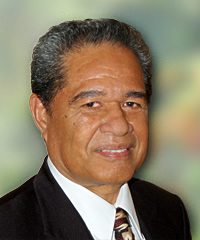Difference between revisions of "Pita Hopoate"
| Line 1: | Line 1: | ||
[[image: Mormon_Pita_Hopoate.jpg|150px|left|alt=Mormon Pita Foliake Hopoate| Mormon Pita Foliake Hopoate]] | [[image: Mormon_Pita_Hopoate.jpg|150px|left|alt=Mormon Pita Foliake Hopoate| Mormon Pita Foliake Hopoate]] | ||
| − | '''Pita Foliake Hopoate''' was one | + | '''Pita Foliake Hopoate''' was one of the longest served, if not the longest served, Area [[Seventy|Seventies]] of [[http://comeuntochrist.org The Church of Jesus Christ of Latter-day Saints]]. |
| − | Elder Hopoate is a native of Tonga, where he served as [[Bishop|bishop]], [[Stake|stake]] president, mission president, regional representative and [[Missionary Training Center]] president prior to his call as an Area Seventy. | + | Elder Hopoate is a native of Tonga, where he served as [[Bishop|bishop]], [[Stake|stake]] president, mission president, [[Regional Representative|regional representative]] and [[Missionary Training Center]] president prior to his call as an Area Seventy. He was a farmer but also worked as a [[Church Educational System]] supervisor. |
Elder Hopoate was the Church Educational System country supervisor for Guam, the Mariana Islands, the Federated States of Micronesia and neighborting countries. As an Area Authority Seventy, he served in the Asia North Area, which consists of the various islands of Micronesia as well as Japan and Korea. | Elder Hopoate was the Church Educational System country supervisor for Guam, the Mariana Islands, the Federated States of Micronesia and neighborting countries. As an Area Authority Seventy, he served in the Asia North Area, which consists of the various islands of Micronesia as well as Japan and Korea. | ||
| − | Elder Hopoate is a graduate of [[Brigham Young University Hawaii]] and was recognized as a distinguished alumni in 2008. | + | Elder Hopoate is a graduate of [[Brigham Young University-Hawaii]] and was recognized as a distinguished alumni in 2008. |
In April 2009 Elder Hopoate was honorably released as an Area Seventy; he had been serving since the first Area Seventies were called in 1995. | In April 2009 Elder Hopoate was honorably released as an Area Seventy; he had been serving since the first Area Seventies were called in 1995. | ||
| Line 14: | Line 14: | ||
*''LDS Church News'', August 5th, 1995; January 30th, 1988; April 21, 1992 | *''LDS Church News'', August 5th, 1995; January 30th, 1988; April 21, 1992 | ||
| − | [[Category:Church Leaders: | + | [[Category:Church Leaders: Past]] |
[[Category:Area seventies]] | [[Category:Area seventies]] | ||
[[Category:Tongan Latter-day Saints]] | [[Category:Tongan Latter-day Saints]] | ||
| Line 21: | Line 21: | ||
[[Category:Regional representatives]] | [[Category:Regional representatives]] | ||
[[Category:Stake presidents]] | [[Category:Stake presidents]] | ||
| − | |||
Revision as of 15:38, 25 May 2021
Pita Foliake Hopoate was one of the longest served, if not the longest served, Area Seventies of [The Church of Jesus Christ of Latter-day Saints].
Elder Hopoate is a native of Tonga, where he served as bishop, stake president, mission president, regional representative and Missionary Training Center president prior to his call as an Area Seventy. He was a farmer but also worked as a Church Educational System supervisor.
Elder Hopoate was the Church Educational System country supervisor for Guam, the Mariana Islands, the Federated States of Micronesia and neighborting countries. As an Area Authority Seventy, he served in the Asia North Area, which consists of the various islands of Micronesia as well as Japan and Korea.
Elder Hopoate is a graduate of Brigham Young University-Hawaii and was recognized as a distinguished alumni in 2008.
In April 2009 Elder Hopoate was honorably released as an Area Seventy; he had been serving since the first Area Seventies were called in 1995.
Sources
- LDS Church Almanac, 2008 Edition, p. 62
- LDS Church News, August 5th, 1995; January 30th, 1988; April 21, 1992
